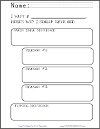| Grade 4 Literacy: Writing |
| www.studenthandouts.com > Grade 4 > Grade 4 ELA > Grade 4 Literacy: Writing |
| Text Types and Purposes |
|---|
| CCSS.ELA-LITERACY.W.4.1: Write opinion pieces on topics or texts, supporting a point of view with reasons and information. |
|---|
CCSS.ELA-LITERACY.W.4.1.A: Introduce a topic or text clearly, state an opinion, and create an organizational structure in which related ideas are grouped to support the writer's purpose. |
|---|
 |
 |
|||||||||
| I want a... Persuasive Argument Graphic Organizer | Five-Paragraph Essay Organizer |
CCSS.ELA-LITERACY.W.4.1.B: Provide reasons that are supported by facts and details. |
|---|
CCSS.ELA-LITERACY.W.4.1.C: Link opinion and reasons using words and phrases (e.g., for instance, in order to, in addition). |
|---|
CCSS.ELA-LITERACY.W.4.1.D: Provide a concluding statement or section related to the opinion presented. |
|---|
CCSS.ELA-LITERACY.W.4.2: Write informative/explanatory texts to examine a topic and convey ideas and information clearly. |
|---|
CCSS.ELA-LITERACY.W.4.2.A: Introduce a topic clearly and group related information in paragraphs and sections; include formatting (e.g., headings), illustrations, and multimedia when useful to aiding comprehension. |
|---|
CCSS.ELA-LITERACY.W.4.2.B: Develop the topic with facts, definitions, concrete details, quotations, or other information and examples related to the topic. |
|---|
CCSS.ELA-LITERACY.W.4.2.C: Link ideas within categories of information using words and phrases (e.g., another, for example, also, because). |
|---|
CCSS.ELA-LITERACY.W.4.2.D: Use precise language and domain-specific vocabulary to inform about or explain the topic. |
|---|
CCSS.ELA-LITERACY.W.4.2.E: Provide a concluding statement or section related to the information or explanation presented. |
|---|
CCSS.ELA-LITERACY.W.4.3: Write narratives to develop real or imagined experiences or events using effective technique, descriptive details, and clear event sequences. |
|---|
| If I had a million dollars... Writing Prompt |
CCSS.ELA-LITERACY.W.4.3.A: Orient the reader by establishing a situation and introducing a narrator and/or characters; organize an event sequence that unfolds naturally. |
|---|
CCSS.ELA-LITERACY.W.4.3.B: Use dialogue and description to develop experiences and events or show the responses of characters to situations. |
|---|
CCSS.ELA-LITERACY.W.4.3.C: Use a variety of transitional words and phrases to manage the sequence of events. |
|---|
CCSS.ELA-LITERACY.W.4.3.D: Use concrete words and phrases and sensory details to convey experiences and events precisely. |
|---|
CCSS.ELA-LITERACY.W.4.3.E: Provide a conclusion that follows from the narrated experiences or events. |
|---|
Production and Distribution of Writing |
|---|
CCSS.ELA-LITERACY.W.4.4: Produce clear and coherent writing in which the development and organization are appropriate to task, purpose, and audience. (Grade-specific expectations for writing types are defined in standards 1-3 above.) |
|---|
CCSS.ELA-LITERACY.W.4.5: With guidance and support from peers and adults, develop and strengthen writing as needed by planning, revising, and editing. (Editing for conventions should demonstrate command of Language standards 1-3 up to and including grade 4 here.) |
|---|
CCSS.ELA-LITERACY.W.4.6: With some guidance and support from adults, use technology, including the Internet, to produce and publish writing as well as to interact and collaborate with others; demonstrate sufficient command of keyboarding skills to type a minimum of one page in a single sitting. |
|---|
Research to Build and Present Knowledge |
|---|
CCSS.ELA-LITERACY.W.4.7: Conduct short research projects that build knowledge through investigation of different aspects of a topic. |
|---|
CCSS.ELA-LITERACY.W.4.8: Recall relevant information from experiences or gather relevant information from print and digital sources; take notes and categorize information, and provide a list of sources. |
|---|
CCSS.ELA-LITERACY.W.4.9: Draw evidence from literary or informational texts to support analysis, reflection, and research. |
|---|
CCSS.ELA-LITERACY.W.4.9.A: Apply grade 4 Reading standards to literature (e.g., "Describe in depth a character, setting, or event in a story or drama, drawing on specific details in the text [e.g., a character's thoughts, words, or actions]."). |
|---|
CCSS.ELA-LITERACY.W.4.9.B: Apply grade 4 Reading standards to informational texts (e.g., "Explain how an author uses reasons and evidence to support particular points in a text"). |
|---|
Range of Writing |
|---|
CCSS.ELA-LITERACY.W.4.10: Write routinely over extended time frames (time for research, reflection, and revision) and shorter time frames (a single sitting or a day or two) for a range of discipline-specific tasks, purposes, and audiences. |
|---|






